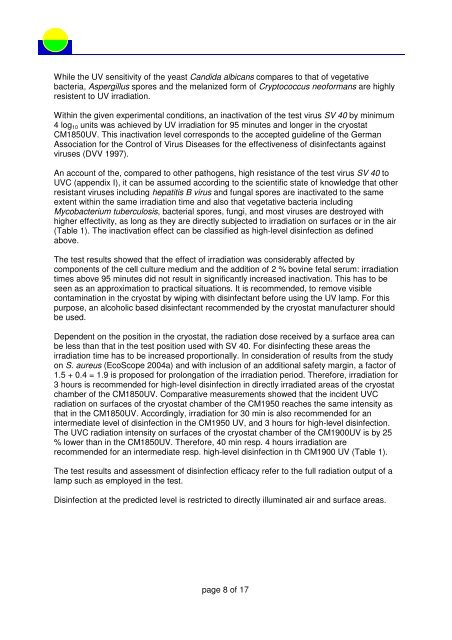CERTIFICATE Inactivation of bacteria, viruses and other pathogens ...
CERTIFICATE Inactivation of bacteria, viruses and other pathogens ...
CERTIFICATE Inactivation of bacteria, viruses and other pathogens ...
You also want an ePaper? Increase the reach of your titles
YUMPU automatically turns print PDFs into web optimized ePapers that Google loves.
While the UV sensitivity <strong>of</strong> the yeast C<strong>and</strong>ida albicans compares to that <strong>of</strong> vegetative<br />
<strong>bacteria</strong>, Aspergillus spores <strong>and</strong> the melanized form <strong>of</strong> Cryptococcus ne<strong>of</strong>ormans are highly<br />
resistent to UV irradiation.<br />
Within the given experimental conditions, an inactivation <strong>of</strong> the test virus SV 40 by minimum<br />
4 log10 units was achieved by UV irradiation for 95 minutes <strong>and</strong> longer in the cryostat<br />
CM1850UV. This inactivation level corresponds to the accepted guideline <strong>of</strong> the German<br />
Association for the Control <strong>of</strong> Virus Diseases for the effectiveness <strong>of</strong> disinfectants against<br />
<strong>viruses</strong> (DVV 1997).<br />
An account <strong>of</strong> the, compared to <strong>other</strong> <strong>pathogens</strong>, high resistance <strong>of</strong> the test virus SV 40 to<br />
UVC (appendix I), it can be assumed according to the scientific state <strong>of</strong> knowledge that <strong>other</strong><br />
resistant <strong>viruses</strong> including hepatitis B virus <strong>and</strong> fungal spores are inactivated to the same<br />
extent within the same irradiation time <strong>and</strong> also that vegetative <strong>bacteria</strong> including<br />
Mycobacterium tuberculosis, <strong>bacteria</strong>l spores, fungi, <strong>and</strong> most <strong>viruses</strong> are destroyed with<br />
higher effectivity, as long as they are directly subjected to irradiation on surfaces or in the air<br />
(Table 1). The inactivation effect can be classified as high-level disinfection as defined<br />
above.<br />
The test results showed that the effect <strong>of</strong> irradiation was considerably affected by<br />
components <strong>of</strong> the cell culture medium <strong>and</strong> the addition <strong>of</strong> 2 % bovine fetal serum: irradiation<br />
times above 95 minutes did not result in significantly increased inactivation. This has to be<br />
seen as an approximation to practical situations. It is recommended, to remove visible<br />
contamination in the cryostat by wiping with disinfectant before using the UV lamp. For this<br />
purpose, an alcoholic based disinfectant recommended by the cryostat manufacturer should<br />
be used.<br />
Dependent on the position in the cryostat, the radiation dose received by a surface area can<br />
be less than that in the test position used with SV 40. For disinfecting these areas the<br />
irradiation time has to be increased proportionally. In consideration <strong>of</strong> results from the study<br />
on S. aureus (EcoScope 2004a) <strong>and</strong> with inclusion <strong>of</strong> an additional safety margin, a factor <strong>of</strong><br />
1.5 + 0.4 = 1.9 is proposed for prolongation <strong>of</strong> the irradiation period. Therefore, irradiation for<br />
3 hours is recommended for high-level disinfection in directly irradiated areas <strong>of</strong> the cryostat<br />
chamber <strong>of</strong> the CM1850UV. Comparative measurements showed that the incident UVC<br />
radiation on surfaces <strong>of</strong> the cryostat chamber <strong>of</strong> the CM1950 reaches the same intensity as<br />
that in the CM1850UV. Accordingly, irradiation for 30 min is also recommended for an<br />
intermediate level <strong>of</strong> disinfection in the CM1950 UV, <strong>and</strong> 3 hours for high-level disinfection.<br />
The UVC radiation intensity on surfaces <strong>of</strong> the cryostat chamber <strong>of</strong> the CM1900UV is by 25<br />
% lower than in the CM1850UV. Therefore, 40 min resp. 4 hours irradiation are<br />
recommended for an intermediate resp. high-level disinfection in th CM1900 UV (Table 1).<br />
The test results <strong>and</strong> assessment <strong>of</strong> disinfection efficacy refer to the full radiation output <strong>of</strong> a<br />
lamp such as employed in the test.<br />
Disinfection at the predicted level is restricted to directly illuminated air <strong>and</strong> surface areas.<br />
page 8 <strong>of</strong> 17


